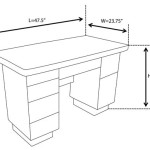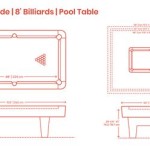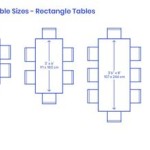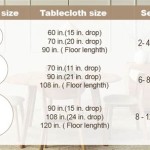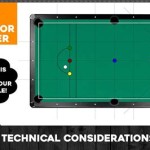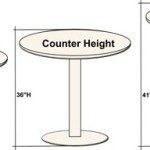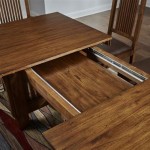The Enduring Appeal and Utility of Wooden TV Tray Tables
Wooden TV tray tables, despite the prevalence of modern furniture options, continue to hold a significant place in many households. Their enduring appeal stems from a combination of practicality, portability, and aesthetic versatility. These tables, characterized by their folding design and relatively small surface area, serve a multitude of purposes beyond simply holding a television dinner. Understanding their construction, design variations, benefits, and proper maintenance allows for a greater appreciation of their ongoing value.
The historical context of the TV tray table is rooted in the post-World War II era, a period marked by increased television ownership and a growing desire for convenience in the home. Early versions were often constructed from metal, but wooden models quickly gained popularity due to their perceived warmth, elegance, and ability to blend more seamlessly with existing home decor. The portability aspect was also key; families could easily move them from room to room, using them as needed for meals, hobbies, or temporary workspaces.
The construction of a wooden TV tray table typically involves several key components. The tabletop itself is usually crafted from solid wood or manufactured wood such as plywood or MDF (Medium-Density Fiberboard). Solid wood offers inherent durability and a natural aesthetic, while engineered wood provides cost-effectiveness and resistance to warping. The frame and legs are similarly constructed, often featuring hinges that allow the table to fold flat for storage. The quality of the wood, the joinery techniques used, and the hardware employed all contribute to the overall stability and longevity of the table.
Design Variations and Aesthetic Considerations
Wooden TV tray tables are available in a diverse range of designs, catering to various stylistic preferences and functional requirements. Traditional designs often feature simple, clean lines and a natural wood finish, emphasizing the inherent beauty of the material. These styles are suitable for classic or rustic interiors. Contemporary designs, on the other hand, may incorporate sleek lines, geometric shapes, and painted or stained finishes in modern colors. These designs frequently prioritize minimalism and functionality.
Beyond the overall style, variations exist in the shape of the tabletop. Rectangular tabletops are the most common, providing ample surface area for a meal or a laptop. Oval or rounded tabletops offer a softer aesthetic and can be particularly suitable for smaller spaces, minimizing the risk of sharp corners. Some models even incorporate features like cup holders or adjustable height mechanisms to enhance their utility.
The choice of wood species also plays a crucial role in the aesthetic appeal of a wooden TV tray table. Hardwoods like oak, maple, and cherry offer superior durability and a rich, distinctive grain pattern. Softwoods like pine are more affordable and often used in rustic or country-style designs. The finish applied to the wood further influences its appearance, ranging from natural oils and waxes that highlight the wood's natural beauty to opaque paints that offer a wider range of color options. Staining allows for color enhancement while still revealing the wood grain.
Practical Benefits and Versatile Applications
The practical benefits of wooden TV tray tables extend far beyond their original intended purpose. Their portability makes them ideal for use in various rooms throughout the house. In the living room, they can serve as a convenient surface for snacks, drinks, or remote controls. In the bedroom, they can function as a bedside table or a makeshift desk. In a home office, they provide a temporary workspace for occasional tasks.
For individuals living in small apartments or dorm rooms, wooden TV tray tables offer a valuable solution for maximizing limited space. Their folding design allows them to be easily stored away when not in use, freeing up valuable floor space. They can also be used as a temporary dining table when entertaining guests, providing additional seating without the need for bulky furniture.
Beyond their convenience and space-saving qualities, wooden TV tray tables can also be used for a variety of hobbies and crafts. Their stable surface provides a suitable platform for activities such as painting, drawing, knitting, or assembling models. The elevated height of the tabletop can also reduce strain on the back and neck, making these activities more comfortable for extended periods.
Furthermore, wooden TV tray tables can be beneficial for individuals with limited mobility. They provide a stable and accessible surface for meals or activities, allowing individuals to maintain independence and comfort. The lightweight design makes them easy to move and position as needed. Some models even feature adjustable height settings to accommodate different needs and preferences.
Maintenance and Preservation of Wooden TV Tray Tables
Proper maintenance is essential for preserving the beauty and longevity of wooden TV tray tables. Regular cleaning with a soft, damp cloth is generally sufficient for removing dust and dirt. Avoid using harsh chemicals or abrasive cleaners, as these can damage the finish of the wood. For stubborn stains, a mild soap solution can be used, followed by a thorough rinsing and drying.
Protecting the wood from excessive moisture is crucial, as prolonged exposure can lead to warping or discoloration. Avoid placing wet glasses or containers directly on the tabletop. Use coasters or placemats to prevent water rings or stains. In humid environments, consider using a dehumidifier to maintain a consistent moisture level.
Periodically applying a wood polish or sealant can help to protect the finish and enhance the wood's natural beauty. Choose a product specifically designed for the type of wood and finish on your table. Follow the manufacturer's instructions carefully, and test the product on an inconspicuous area before applying it to the entire surface.
When storing wooden TV tray tables, keep them in a dry, well-ventilated area. Avoid storing them in direct sunlight or near heat sources, as this can cause the wood to dry out and crack. If possible, store them flat to prevent warping. Regularly inspect the hinges and hardware for signs of wear or damage. Tighten any loose screws or bolts, and replace any damaged parts as needed.
Addressing scratches and minor damage promptly can prevent them from worsening over time. Small scratches can often be concealed with a wood filler or touch-up stain that matches the color of the wood. Deeper scratches may require sanding and refinishing. Consult with a professional furniture repair specialist for more extensive damage.
The choice of wood finishing products also impacts the ease of maintenance. Polyurethane finishes offer excellent protection against scratches and moisture, making them suitable for high-use areas. Oil-based finishes, while offering a richer luster, may require more frequent maintenance. Wax finishes provide a natural look and feel but offer less protection against moisture.
The enduring appeal of wooden TV tray tables lies in their ability to combine practicality with aesthetic charm. Their versatility, portability, and space-saving design make them a valuable addition to any home. By understanding their construction, design variations, benefits, and proper maintenance, one can fully appreciate the enduring utility of these unassuming pieces of furniture.

Hardwood Single Tv Tray From Dutchcrafters Amish Furniture

Tv Tray Wood Natural Plastic Dev Group Target

Tv Tray Wood Plastic Dev Group Target

5 Piece Wood Tv Tray Set 4 Trays 1 Stand In Natural Pdg Com

Hardwood Folding Tv Tray Set By Dutchcrafters Amish Furniture

5pc Tv Tray Set Wood Natural Plastic Dev Group Target

Pj Wood Folding Tv Tray Tables With Compact Storage Rack Espresso 5 Piece Set 1 Kroger

Amish Made Solid Wood Tv Trays

Tv Tray Set With Stand Folding Tables

For Living Portable Wood Folding Tv Tray Laptop Side End Table Canadian Tire

